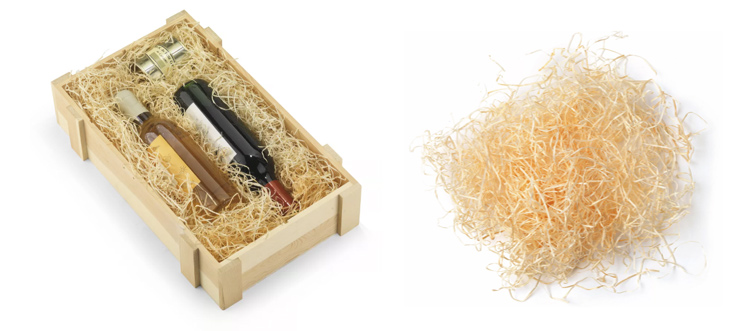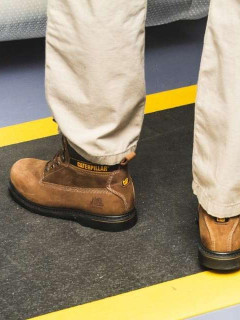Wood wool is a timeless classic for wrapping fragile gifts or products. But did you know that this is just the tip of the iceberg in terms of applications? As a packaging material, wood wool has so much more to offer than just a nice finish and protection. Explore the story behind wood wool with us from needle to thread and find out what benefits it can bring to your business.
1. What are the advantages of packing with wood wool?
As a filling material, wood wool is a true timeless classic. Imagine a wine bottle resting safely on a bed of wood shavings. That makes for a warm and inviting feeling, doesn’t it? But wood shavings offer more than just a stylish look. Check out all the benefits of packing with woodwool filling material below.
► 1.1 Stylish and environmentally friendly presentation
Sustainable packaging has become an indispensable trend in the world of e-commerce. Alongside modern ecological solutions, wood shavings have been shining as an eco-friendly packaging material for years. When a product with wood shavings is shipped to the end customer, it creates more than just a sustainable image. Elegant products such as wine bottles or gift baskets benefit from a high-quality and decorative presentation, especially during the holidays.
► 1.2 Protecting your products… and even export them
To pack and ship safely, you need padding material. This way, your delicate products are firmly protected during transport. Just like padding chips, for example, wood wool offers a perfect solution here. You can, for instance, use it to ship extra fragile products such as wine bottles or porcelain.
Moreover, wood shavings comply with the ISPM15 standard for wooden packaging materials. When producing wood shavings, the raw material is exposed to very high temperatures. As a result, they can no longer carry harmful organisms and therefore pose no risk for export. Shipping a parcel abroad? With wood shavings, you always play it safe.

2. How is wood wool padding material made?
The origins of wood wool take us back to the 1840s in the United States, where production found its humble beginnings. Europe followed only 40 years later, along with the emergence of industrial machinery. Today, the production of wood shavings proceeds in a more modern way:
| . 1. Collect |
In winter, FSC-certified timber is purchased directly from the local forester, who manages the forest in a sustainable way. The approved trees are then cut into large pieces for transport and storage. They are stored until the next spring. |
| . 2. Preparing |
In spring, the wood is thoroughly inspected, debarked and cut to a smaller length. Special types of wood such as moonwood are kept separately to dry in the open air. These special species are used for special applications. |
| . 3. Processing |
1 year later, production of the wood pieces begins. The wood is further cut to the right length for the planers and sorted according to end use. Then the planers plane wood shavings from the finely cut pieces of wood. |
| . 4. Finishing |
During the final stage, all dust and splinters are removed from the wood wool. This way, this wool is safe, hygienic and ready for use. Once finished, the wood wool is collected and packed, ready for export. |
3. What other uses does wood wool have?
Thanks to its surprisingly versatile properties, wood shavings are used in various sectors. Decoration, padding, natural kindling, insulation… you name it. Moreover, wood wool exists in different variants: from superfine to coarse (width: 0.51 to 4.42 mm). Furthermore, there are wood wool types that are specially processed depending on their function. Besides packaging material, these are the most common applications:
► Animal hygiene and nesting material
The true animal lover can choose different types of useful wood wool. In livestock farms or animal shelters, for example, one chooses hygienic wood wool. This variant does not absorb dust, contains no splinters and is particularly soft. With it, livestock farmers clean, for example, the udders of cows, sheep or goats comfortably and hygienically.
Soft wood shavings can also be used to make a warm and comfortable nest. Ideal for playing or sleeping in. In addition, this material optimally absorbs urine and moisture, keeping the nest dry. It is often used in hamster nests and insect hotels, among other things.
► Horticulture
From the many types of wood wool, there are also variants to suit individuals with ‘green fingers’. With specially processed wood wool, you can offer your crops natural protection. For example, you can choose from a special wood wool that creates a buffer between your crop and the soil. This gives the plant and its fruit extra protection against dirt, moisture and frost, among other things.
On the other hand, some types of wood wool keep harmful insects at bay. Since beneficial insects prefer the natural material as an ideal nest, they form a barrier against harmful insects. As a result, ecological pest control takes place. Essential oils from the specially processed wood shavings also keep snails at bay.
► Insulation material
Due to their thermal properties, wood shavings retain heat very well and do not let cold through. On top of that, wood shavings are a good moisture regulator for indoors. When moisture levels are high, it absorbs moisture very easily.
Although wood wool burns very quickly, this is not the case for insulation panels. Wood wool for insulation panels undergoes treatment with borate salt, so that they come out fire-resistant and even mould-resistant. They are then compressed with a binder to form an insulation panel.
► Lighting cubes
Wood wool firelighters are designed to ignite effortlessly and create a strong flame that spreads easily to firewood or charcoal. They are useful for lighting wood stoves, barbecues and fire pits. Moreover, they produce less smoke compared to other lighting methods.















